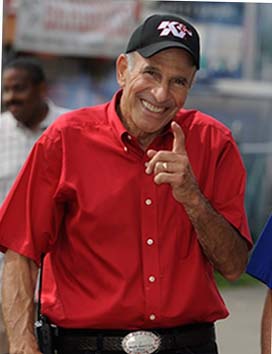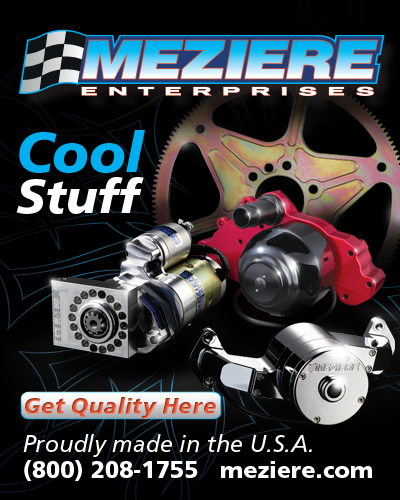BILL BADER SR: THE MAN WHO MADE IT COOL TO BE KIND
by Jon Asher; Photos courtesy of NHRA,com Mon, 2022-06-27 23:40
BILL BADER, SR. 1943-2022

We lost a great friend on Sunday. Wait – everyone who’s ever participated in, or witnessed or even thought about drag racing lost a very good friend on Sunday with the passing of Bill Bader, Sr. following an accident on the property he shared with his wife, Debbie, in Idaho.
Those of you with calculators in your heads are now thinking, “Hold on, wasn’t the NHRA national event at Norwalk this weekend? Why wasn’t he there?” Bill hasn’t set foot on the Summit Racing Equipment Motorsports Park grounds (and let’s just call it “Norwalk,” as everyone does) in years, not since he turned the day-to-day operations over to his son, Bill, Jr. Of course, he’s been in town numerous times when the race has taken place, but he’s never been out there to see it for himself. “I have a lot of friends out there,” he once said. “It’s Billy’s track now, so the spotlight should be on him, not me.”
Bader was a somewhat unique individual in the annals of drag racing in that he appeared to be completely egoless. While others may seek and relish the limelight, Bader preferred to let the spotlight shine brightly on others as he quietly – and sometimes not so quietly – worked in the background. Of course, after building up what was once called Norwalk Raceway Park into a showplace facility, and then rescuing a moribund International Hot Rod Association that appeared destined for the trash heap of history ,it became more and more difficult to turn that spotlight on others. Simply put, by seeing his achievements everyone from the Ohio business community to the nation’s most rabid drag racing fans realized they were witnessing the ascension of a once-in-a-lifetime marketing/management genius.
Despite his physical absence from Norwalk, Bill, Sr. remained a critically important sounding board for his son’s ideas. He never interfered, never tried to exert his will on what Bill, Jr. wanted to try, but remained ready, willing and more than able to discuss concepts both big and small.
Time for an ice cream story? If you’ve ever been to the track you undoubtedly know about the homemade ice cream that goes for $1 per pound. That’s not a misprint. It’s one dollar per pound! So, it’s during the management transition between the Senior and Junior Baders, and young Bill says to his dad, “Ya know, that homemade ice cream we buy is expensive. We lose money on it every week. I think we should switch to some commercial brand that’ll cost a lot less.” Without missing a beat Senior says, “Go ahead and try it. I don’t think it’ll work, but it’s your deal.”
Need I outline the complaints? The steeply declining sales? The spectator disappointment in the commercial product? It took about three weeks to make the switch back to the “real stuff,” The “real stuff” still keeps the line by the ice cream window on the east side of the track about 45-minutes long at the major events – and nobody seems to mind the wait.
By the way, the single most coveted “trophy” in NHRA drag racing isn’t the Wally, it’s the ice cream scoops given to winners of the Summit Racing Equipment Nationals.
In more than 50 years of drag racing involvement ,Bill Bader, Sr., and now his son, are the lone track operators I’ve ever had the pleasure of dealing with who were – and remain – beloved by both the competitors and fans. In far too many instances the relationship between racers, fans and track management has been one of animosity at best, and outright warfare at worst. There’s none of that when it comes to Norwalk, and it’s all because of the tone Bill, Sr. set years ago

There isn’t a racer reading this who can’t recall pulling up to some track’s gate and being met with a “Whadd’ya want?” inquiry from some Rent-A-Thug. That never happens at Norwalk, where every uniformed, smiling employee politely greets every arrival with a “How are you doin’ today?” and “How can we help you?” query. Yeah, it takes some getting used to!
Among the lessons that Bill. Sr. impressed upon his son, and more than willingly tried to share with other track owners, is that every person who’s willing to buy a ticket, or wants to come and race, or hopes to assist his racer clients with products and service, is a customer first and foremost, and must be treated with respect and courtesy. Those are words that, unfortunately, have never entered the vocabulary of some other operators.
Before signing with NHRA Norwalk was the home of the IHRA World Nationals, that organization’s biggest and most important event. It was common knowledge that before Bader took over ownership of the organization the management of IHRA always looked forward to the World Nationals. As one senior executive most tellingly put it, ”It’s our chance to get (financially) healthy,” for he knew that regardless of what happened at other venues, the facility at Norwalk would be immaculate, the fans would be happy with the on-track action, and the racers – in no small measure because of Bill, Sr’s attitudes and action – would be glad they were there.
When Bader took over IHRA in 1998 he quickly became aware of how little some of his member tracks understood about marketing, management and the future. When he broached the subject of advanced ticket sales during an early track owners meeting his comments were met with blank stares, for most of them had never thought of it. When he explained that, while it might be January on the calendar, Norwalk already had $150,000 in the bank in World Nationals advanced ticket sales, money that he wouldn’t have to “spend” until the August race date, everyone was eager to jump aboard.
When he visited a southern track for its first IHRA race the owner proudly showed Bill around, pointing out all the improvements he’d made. The owner couldn’t understand Bill’s responses of “Yeah, but…” until he’d hopped in Bader’s car and driven out to the highway, where Bader pointed to the broken down, unpainted track sign and said, “That sign is the first thing your prospective customer sees, and if it looks like that he’s going to assume that everything inside the gate is in the same condition.” Message delivered and received. A new billboard was in place by the next morning.
That customer service thing? One year at Norwalk Bader was asked by the arriving media people, “What’s new?” While others might have boastfully talked about their new launching pad, or finish line signboards, Bader proudly talked about what really counted. “We’ve built $600,00 in new bathrooms,” he said. “Most of them are for women, and they include showers with full time employees to make sure they have privacy and everything else they need for a nice day.”
Six hundred thousand dollars? Most track operators are reluctant to spend $600 for a new ticket booth!
We can’t talk about Bill Bader. Sr. without referencing the greatest single day event in all of drag racing, the August Night Under Fire, an extravaganza that absolutely must be seen to fully comprehend. Don’t worry, you won’t be alone in Norwalk’s massive grandstands. There’ll be about 30,000 other screaming fans right with you! An 8-car Funny Car show highlighted by annual superstar John Force anchors the program, but that’s far from the extent of it. Top Dragsters are a throw-in with early Gassers, jet dragsters, jet-powered trucks, wheelstanders, and a great deal more. It’s impossible to list every participating act of madness, because the cast changes year to year. But as Force said one year as he grabbed the microphone from Bill, Sr. during the pre-race parade, “You’re gonna see some shit tonight you’ve never seen before!” Amen, Brother Force! And it’ll all be capped off with a stunningly impressive fireworks show, a show big enough to rival that of a mid-sized city.
Why did Bill Bader, Sr. add that mid-six figure fireworks show to the program? For the fans, of course. It’s always all about them, and clearly, Bill, Jr. follows that same credo.
Under Bill, Sr’s guidance the track built up an email list that approached 50,000 names – and they stayed in contact with those fans on a regular basis. Nowadays those contacts are maintained through texting and social media. They treated their regular racers the same way, as friends first and then customers. If a competitor didn’t come out for a month or so he or she might get a personal call from Mr. Bill. He never asked why the racer wasn’t coming out, he asked how things were, how’s the family, how’s work going. He asked because he actually cared more about that individual’s “real” life than their racing life

Under Bill, Sr’s leadership the track did extensive research into fan motivation: What brought them out, what did they want to see. Interestingly, their studies indicated that the crowd for the NHRA national event isn’t the same group that comes out for the Night Under Fire, so they adjusted their promotions accordingly, enhancing both events. When a track understands its audience the odds are it’s going to make the right decisions when it comes providing that all-important “customer service.” Take, for but one example of painful-to-make-but-never-the-less-the right decision, the 2016 Night Under Fire. The NUF program gets underway promptly at 6:00 PM, with the last firework lighting the sky a little after 9:00 PM, but in ’16 there was one of those slow, never-ending rains which was supposed to stop right about the time to show was to start. The two Baders met in the tower control center to discuss their options. They mutually agreed that even if the rain stopped promptly at six o’clock they wouldn’t be able to dry the track before eight, which meant the show probably wouldn’t end before midnight, which in turn meant many of their fans – most with children – wouldn’t get home before the early morning hours. “Even if they love the show,” Bill, Sr. offered, “they’re going to get home tired, with exhausted kids.” At 5:20PM they called it a rainout.
But here’s the thing. The fans not only understood the thinking behind the decision, they supported it. This writer passed no less than three separate groups of fans on the way to the parking lot, with all three expressing sympathy for the Baders. In those five decades of drag racing mentioned earlier I never once heard a word of sympathy uttered for either a race track owner or a sanctioning organization. Not once.
What’s the difference when it comes to Bill Bader, Sr? It’s because those fans, and the hundreds of racers who look forward to competing at Norwalk every year, know they’re going to be treated fairly, respectfully and almost as family members, because Bill Bader. Sr. wouldn’t have it any other way.
Bader leaves behind his wife, Debbie, son Bill, Jr. and daughters Bobbie, Kelly and Lisa and four grandchildren. Funeral and memorial services are pending at this point, but will be announced shortly.
Categories:





































